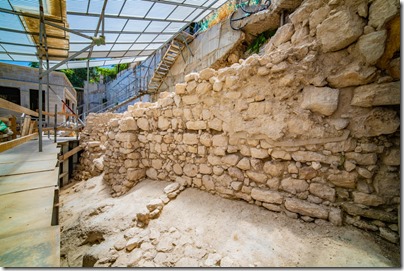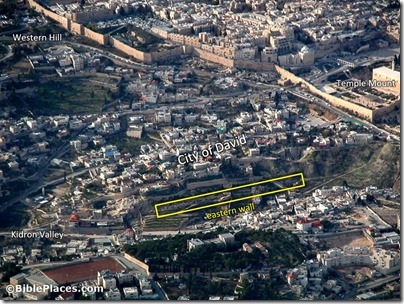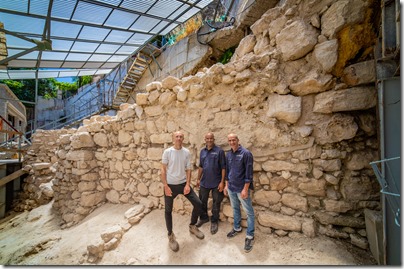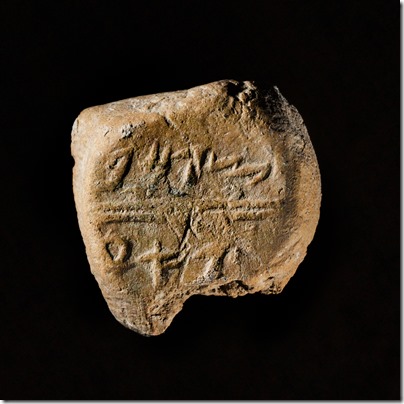Archaeologists have announced the discovery of a portion of Jerusalem’s city wall dating to the time of Hezekiah and Josiah. The story is reported in many outlets, including The Times of Israel, The Jerusalem Post, and Haaretz. A 2-minute video has been created by the Israel Antiquities Authority. Here are the main points:
Newly discovered wall; photo by Koby Harati/City of David
Location: The excavated portion is on the eastern slope of the City of David just south of the Gihon Spring, between previously known sections of this wall to the north (a 100-foot section in Kathleen Kenyon’s trench) and to the south (a 300-foot section in Yigal Shiloh’s Area E).
City of David from the southeast; marked portion shows entire extent of all wall sections discovered to date
Size: The excavated sections are about 15 feet (5 m) wide and up to 10 feet (3 m) high. One section is 130 feet (40 m) long, and the other is 10 feet (3 m) long.
Date: The wall is believed to have been built in the late 8th or early 7th centuries BC. This corresponds to the reign of Hezekiah whose sole reign was from 715 to 686 BC. The archaeologists have not determined if the wall was built before or after the Assyrian invasion in 701. We do know that Hezekiah built a massive wall (the “broad wall”) on Jerusalem’s western hill (cf. Isa 22:10). The archaeologists have not yet received results from material submitted for radiocarbon dating.
Archaeologists: The excavation was directed by Filip Vukosavović of the Ancient Jerusalem Research Center and Joe Uziel and Ortal Chalaf on behalf of the Israel Antiquities Authority.
Archaeologists (from l to r): Vukosavović, Chalaf, Uziel; photo by Koby Harati/City of David
Significance: The discovery ends the debate that portions of the wall found by Kenyon and Shiloh were not city fortification walls. These three known sections allow archaeologists to reconstruct the line of Jerusalem’s eastern wall for about 650 feet (200 m).
Small finds: Near the wall, archaeologists uncovered a building, LMLK seal impressions, rosette-stamped handles, a Babylonian stamp seal, and a seal impression with the name “Tsafan.”
Seal of Tsafan; photo by Koby Harati/City of David
Contradiction: Stories are more interesting if there is a conflict, and so some reporters have framed this discovery of a standing wall as a “contradiction” to the biblical notice in 2 Kings 25:10 that the Babylonians destroyed all of Jerusalem’s walls. But this is a poor interpretation of the biblical text.
Response:
- In the context of 2 Kings, the Babylonians had previously besieged Jerusalem (in 597; 2 Kgs 24:20-17), but they did not destroy the walls when they captured the city. This time (in 586), they destroyed the walls.
- Contrary to some translations in the news reports, 2 Kings 25:10 simply reads that the Babylonians “destroyed the walls around Jerusalem.” It does not say that they destroyed every wall in every place.
- By destroying the walls around Jerusalem, the biblical author is indicating the extent of the damage. The Babylonians did not destroy only the massive (broad) wall on the northern side.
- The destruction of a wall does not require removing every stone from its place. By comparison, the Romans destroyed the Temple Mount and knocked down many but not all of its stones.
- The archaeologists have suggested that this portion of the wall was not torn down because the slope of the hill in this area is quite steep, making it more difficult to access.
- That the Babylonians sufficiently destroyed Jerusalem’s walls is evident from the fact that the city lay in ruins for many years, and the reconstruction of the walls required a major effort under Nehemiah.
- Imagine if today’s Old City walls of Jerusalem were destroyed, but that stretches of the wall were preserved to 10 or 15 feet in height. Would it be inaccurate to say that the walls around Jerusalem were destroyed?
Conclusion: This is an outstanding discovery that contributes significantly to our knowledge of ancient Jerusalem. There is no need to try to make it more exciting by inventing contradictions.




One thought on “Ancient City Wall Discovered in Jerusalem”
Thank you for the clear and sane coverage of this item. This is very helpful apologetic information.